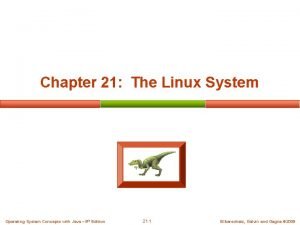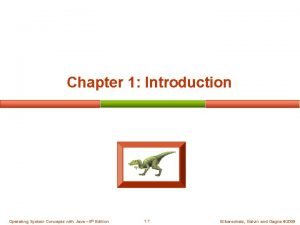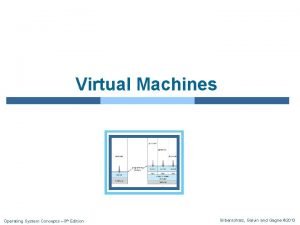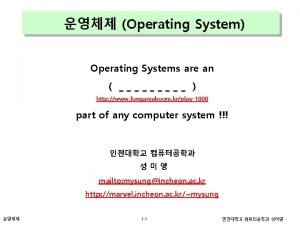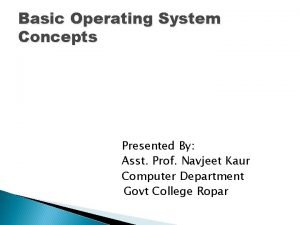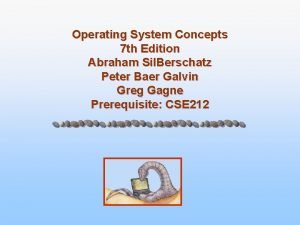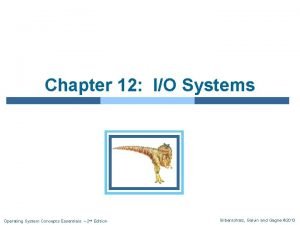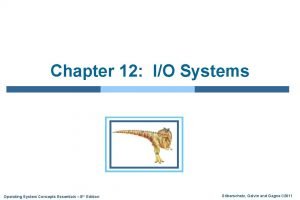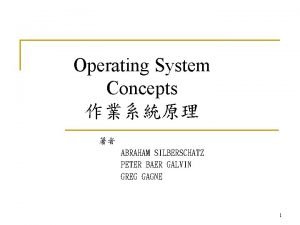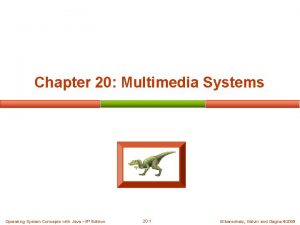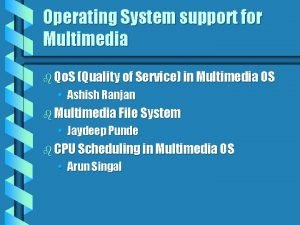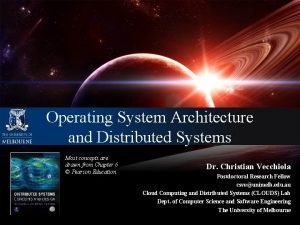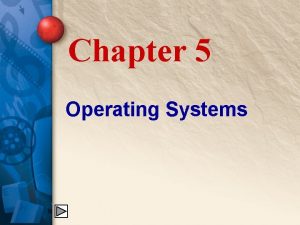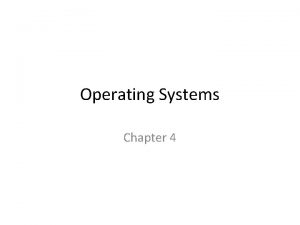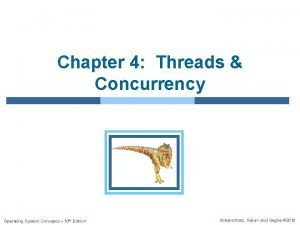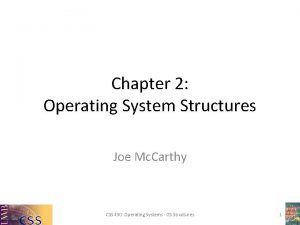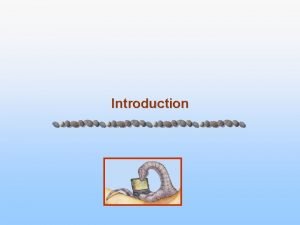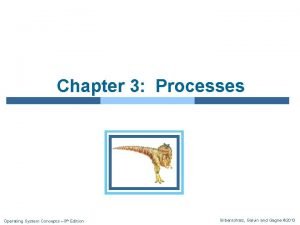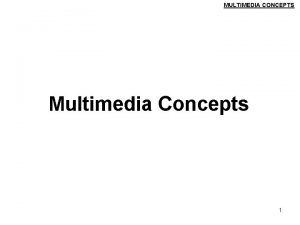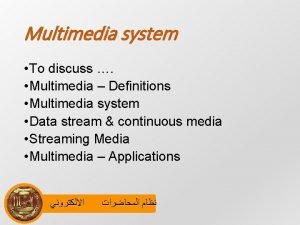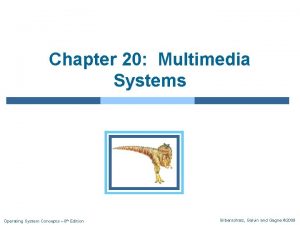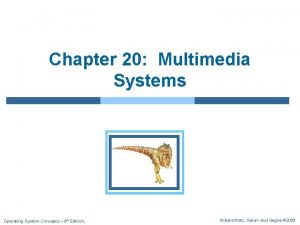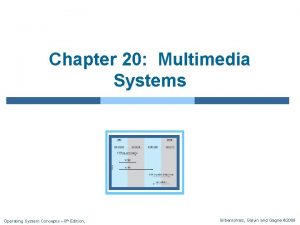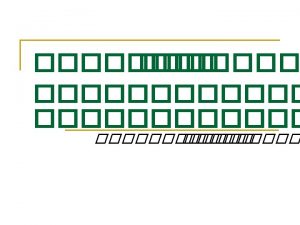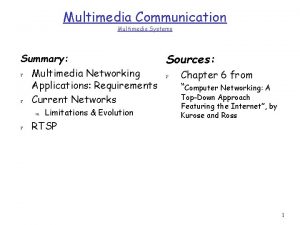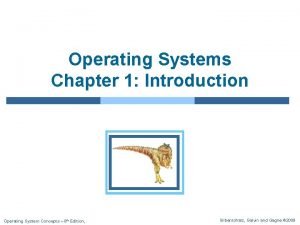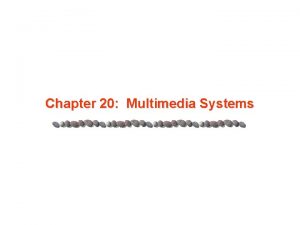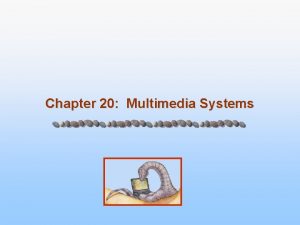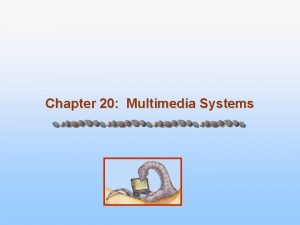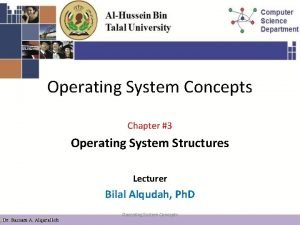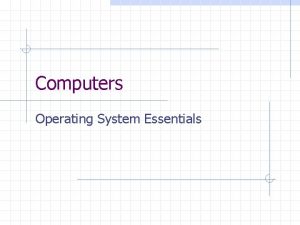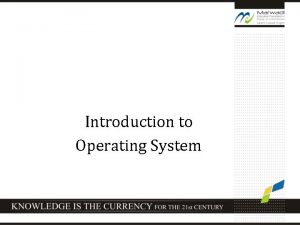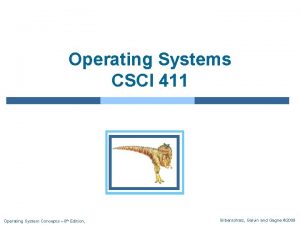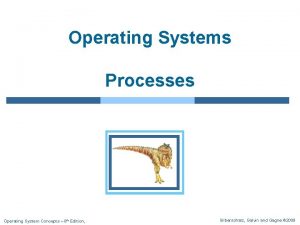Chapter 20 Multimedia Systems Operating System Concepts with

































- Slides: 33

Chapter 20: Multimedia Systems Operating System Concepts with Java – 7 th Edition, Nov 15, 2006 Silberschatz, Galvin and Gagne © 2007

Chapter 20: Multimedia Systems p p p p What is Multimedia Compression Techniques Requirements of Multimedia Kernels CPU Scheduling Disk Scheduling Network Management An Example: Cineblitz Operating System Concepts with Java – 7 th Edition, Nov 15, 2006 20. 2 Silberschatz, Galvin and Gagne © 2007

Objectives p p p To identify the characteristics of multimedia data To examine several algorithms used to compress multimedia data To explore the operating system requirements of multimedia data, including CPU and disk scheduling and network management Operating System Concepts with Java – 7 th Edition, Nov 15, 2006 20. 3 Silberschatz, Galvin and Gagne © 2007

What is Multimedia? p Multimedia data includes - audio and video clips (i. e. MP 3 and MPEG files) - live webcasts p Multimedia data may be delivered to - desktop PC’s - handheld devices (PDAs, smart phones Operating System Concepts with Java – 7 th Edition, Nov 15, 2006 20. 4 Silberschatz, Galvin and Gagne © 2007

Media Delivery p p Multimedia data is stored in the file system like other ordinary data. However, multimedia data must be accessed with specific timing requirements. For example, video must be displayed at 24 -30 frames per second. Multimedia video data must be delivered at a rate which guarantees 24 -30 frames/second. Continuous-media data is data with specific rate requirements. Operating System Concepts with Java – 7 th Edition, Nov 15, 2006 20. 5 Silberschatz, Galvin and Gagne © 2007

Streaming p p Streaming is delivering a multimedia file from a server to a client - typically the deliver occurs over a network connection. There are two different types of streaming: 1. Progressive download - the client begins playback of the multimedia file as it is delivered. The file is ultimately stored on the client computer. 2. Real-time streaming - the multimedia file is delivered to - but not stored on - the client’s computer. Operating System Concepts with Java – 7 th Edition, Nov 15, 2006 20. 6 Silberschatz, Galvin and Gagne © 2007

Real-time Streaming p There are two types of real-time streaming: (1) Live streaming - used to deliver a live event while it is occurring. (2) On-demand streaming - used to deliver media streams such as movies, archived lectures, etc. The events are not delivered in real-time. Operating System Concepts with Java – 7 th Edition, Nov 15, 2006 20. 7 Silberschatz, Galvin and Gagne © 2007

Multimedia Systems Characteristics p Multimedia files can be quite large. p Continuous media data may require very high data rates. p Multimedia applications may be sensitive to timing delays during playback of the media. Operating System Concepts with Java – 7 th Edition, Nov 15, 2006 20. 8 Silberschatz, Galvin and Gagne © 2007

Compression p p Because of the size and rate requirements of multimedia systems, multimedia files are often compressed into a smaller form. MPEG Compression: (1) MPEG-1 - 352 X 240 @ 30 frames/second (2) MPEG-2 - Used for compressing DVD and high-definition television (HDTV) (3) MPEG-4 - Used to transmit audio, video, and graphics. Can be delivered over very slow connections (56 Kbps) Operating System Concepts with Java – 7 th Edition, Nov 15, 2006 20. 9 Silberschatz, Galvin and Gagne © 2007

Operating Systems Issues p The operating system must guarantee the specific data rate and timing requirements of continuous media. p Such requirements are known as Quality-of-Service (Qo. S) guarantees. Operating System Concepts with Java – 7 th Edition, Nov 15, 2006 20. 10 Silberschatz, Galvin and Gagne © 2007

Qo. S Guarantees p Guaranteeing Qo. S has the following effects in a computer system: (1) CPU processing (2) Scheduling (3) File systems (4) Network protocols Operating System Concepts with Java – 7 th Edition, Nov 15, 2006 20. 11 Silberschatz, Galvin and Gagne © 2007

Requirement of Multimedia Operating Systems p There are three levels of Qo. S (1) Best-effort service - the system makes a best effort with no Qo. S guarantees. (2) Soft Qo. S - allows different traffic streams to be prioritized, however no Qo. S guarantees are made. (3) Hard Qo. S - the Qo. S rquirements are guaranteed. Operating System Concepts with Java – 7 th Edition, Nov 15, 2006 20. 12 Silberschatz, Galvin and Gagne © 2007

Parameters Defining Qo. S p Throughput - the total amount of work completed during a specific time interval. p Delay - the elapsed time from when a request is first submitted to when the desired result is produced. p Jitter - the delays that occur during playback of a stream. p Reliability - how errors are handled during transmission and processing of continuous media. Operating System Concepts with Java – 7 th Edition, Nov 15, 2006 20. 13 Silberschatz, Galvin and Gagne © 2007

Further Qo. S Issues p p Qo. S may be negotiated between the client and server. Operating systems often use an admission control algorithm that admits a request for a service only if the server has sufficient resources to satisfy the request. Operating System Concepts with Java – 7 th Edition, Nov 15, 2006 20. 14 Silberschatz, Galvin and Gagne © 2007

Resources on a file server Operating System Concepts with Java – 7 th Edition, Nov 15, 2006 20. 15 Silberschatz, Galvin and Gagne © 2007

CPU Scheduling p Multimedia systems require hard realtime scheduling to ensure critical tasks will be serviced within timing deadlines. p Most hard realtime CPU scheduling algorithms assign realtime processes static priorities that do not change over time. Operating System Concepts with Java – 7 th Edition, Nov 15, 2006 20. 16 Silberschatz, Galvin and Gagne © 2007

Disk Scheduling p Disk scheduling algorithms must be optimized to meet the timing deadlines and rate requirements of continuous media. p Earliest-Deadline-First (EDF) Scheduling p SCAN-EDF Scheduling Operating System Concepts with Java – 7 th Edition, Nov 15, 2006 20. 17 Silberschatz, Galvin and Gagne © 2007

Disk Scheduling (cont) p The EDF scheduler uses a queue to order requests according to the time it must be completed (its deadline. ) p SCAN-EDF scheduling is similar to EDF except that requests with the same deadline are ordered according to a SCAN policy. Operating System Concepts with Java – 7 th Edition, Nov 15, 2006 20. 18 Silberschatz, Galvin and Gagne © 2007

Deadline and cylinder requests for SCAN-EDF scheduling Operating System Concepts with Java – 7 th Edition, Nov 15, 2006 20. 19 Silberschatz, Galvin and Gagne © 2007

Network Management p Three general methods for delivering content from a server to a client across a network: (1) Unicasting - the server delivers the content to a single client. (2) Broadcasting - the server delivers the content to all clients, regardless whether they want the content or not. (3) Multicasting - the server delivers the content to a group of receivers who indicate they wish to receive the content. Operating System Concepts with Java – 7 th Edition, Nov 15, 2006 20. 20 Silberschatz, Galvin and Gagne © 2007

Realtime Streaming Protocol (RTSP) p Standard HTTP is stateless whereby the server does not maintain the status of its connection with the client. Operating System Concepts with Java – 7 th Edition, Nov 15, 2006 20. 21 Silberschatz, Galvin and Gagne © 2007

Streaming media from a conventional web server Operating System Concepts with Java – 7 th Edition, Nov 15, 2006 20. 22 Silberschatz, Galvin and Gagne © 2007

Realtime Streaming Protocol Operating System Concepts with Java – 7 th Edition, Nov 15, 2006 20. 23 Silberschatz, Galvin and Gagne © 2007

RTSP States p SETUP - the server allocates resources for a client session. p PLAY - the server delivers a stream to a client session. p PAUSE - the server suspends delivery of a stream. p TEARDOWN - the server breaks down the connection and releases the resources allocated for the session. Operating System Concepts with Java – 7 th Edition, Nov 15, 2006 20. 24 Silberschatz, Galvin and Gagne © 2007

RTSP state machine Operating System Concepts with Java – 7 th Edition, Nov 15, 2006 20. 25 Silberschatz, Galvin and Gagne © 2007

Cine. Blitz Multimedia Server p Cine. Blitz supports both realtime and non-realtime clients. p Cine. Blitz provides hard Qo. S guarantees to realtime clients using an admission control algorithm. p The disk scheduler orders requests using C-SCAN order. Operating System Concepts with Java – 7 th Edition, Nov 15, 2006 20. 26 Silberschatz, Galvin and Gagne © 2007

Cine. Blitz Admission Controller p Total buffer space required for N clients where client has rate requirement of ri Operating System Concepts with Java – 7 th Edition, Nov 15, 2006 20. 27 Silberschatz, Galvin and Gagne © 2007

Double buffering in Cine. Blitz Operating System Concepts with Java – 7 th Edition, Nov 15, 2006 20. 28 Silberschatz, Galvin and Gagne © 2007

Cine. Blitz Admission Controller (cont) p If tseek and trot are the worst-case seek and rotational delay times, the maximum latency for servicing N requests is Operating System Concepts with Java – 7 th Edition, Nov 15, 2006 20. 29 Silberschatz, Galvin and Gagne © 2007

Cine. Blitz Admission Controller (cont) p The Cine. Blitz admission controller only admits a new client if there is at least 2 X T X ri bits of free buffer space and the following equation is satisfied Operating System Concepts with Java – 7 th Edition, Nov 15, 2006 20. 30 Silberschatz, Galvin and Gagne © 2007

End of Chapter 20 Operating System Concepts with Java – 7 th Edition, Nov 15, 2006 Silberschatz, Galvin and Gagne © 2007

In. 20. 1 Operating System Concepts with Java – 7 th Edition, Nov 15, 2006 20. 32 Silberschatz, Galvin and Gagne © 2007

Exercise 20. 10 Operating System Concepts with Java – 7 th Edition, Nov 15, 2006 20. 33 Silberschatz, Galvin and Gagne © 2007
 Operating system concepts chapter 8 solutions
Operating system concepts chapter 8 solutions Operating system concepts chapter 5 solutions
Operating system concepts chapter 5 solutions Operating system concepts chapter 5 solutions
Operating system concepts chapter 5 solutions Operating systems
Operating systems Operating system
Operating system Linux operating system concepts
Linux operating system concepts Operating system concepts with java
Operating system concepts with java Operating system concepts 6th edition
Operating system concepts 6th edition Operating system concepts 9
Operating system concepts 9 Real time characteristics of embedded operating systems
Real time characteristics of embedded operating systems 교보 drm
교보 drm Basic concepts of os
Basic concepts of os Operating system concepts 11th
Operating system concepts 11th Operating system concepts essentials
Operating system concepts essentials Operating system concepts essentials
Operating system concepts essentials Abraham silberschatz
Abraham silberschatz Multimedia operating system
Multimedia operating system Multimedia operating system
Multimedia operating system What is operating system architecture
What is operating system architecture Multimedia becomes interactive multimedia when
Multimedia becomes interactive multimedia when Linear multimedia example
Linear multimedia example Linear and nonlinear multimedia
Linear and nonlinear multimedia Esa multimedia.esa.int./multimedia/virtual-tour-iss
Esa multimedia.esa.int./multimedia/virtual-tour-iss Buddy system operating system
Buddy system operating system File system in operating system
File system in operating system File system in operating system
File system in operating system File system in operating system
File system in operating system Type of network operating system
Type of network operating system Types of operating system
Types of operating system Chapter 4 operating system
Chapter 4 operating system Chapter 4 operating system
Chapter 4 operating system Device management system calls
Device management system calls Operating system chapter 1
Operating system chapter 1 Operating system chapter 3
Operating system chapter 3





